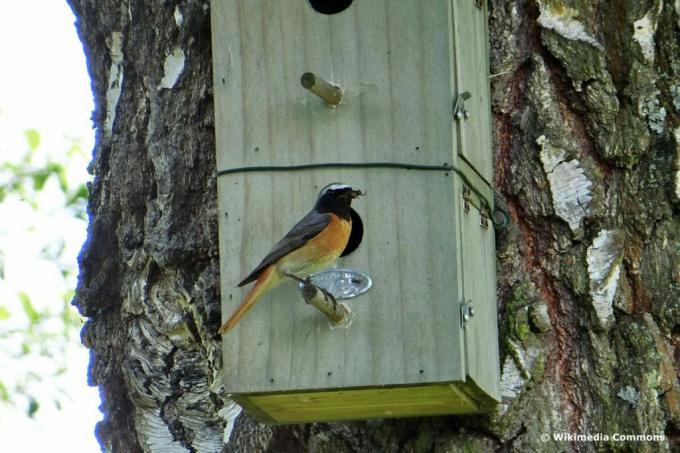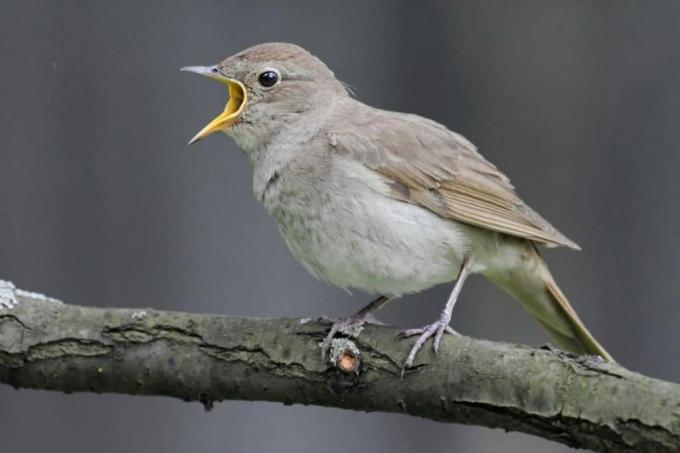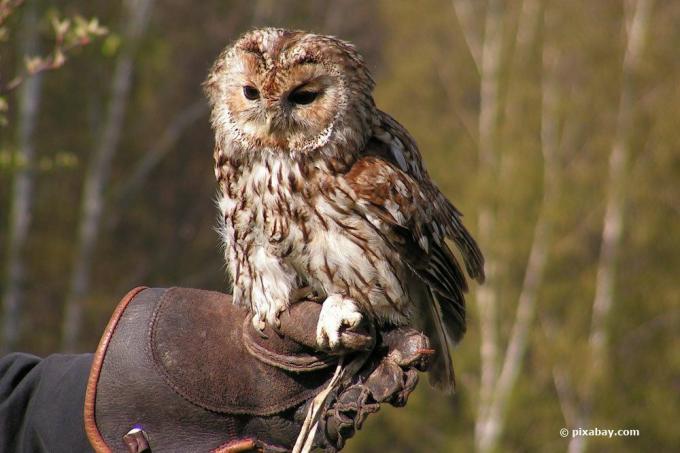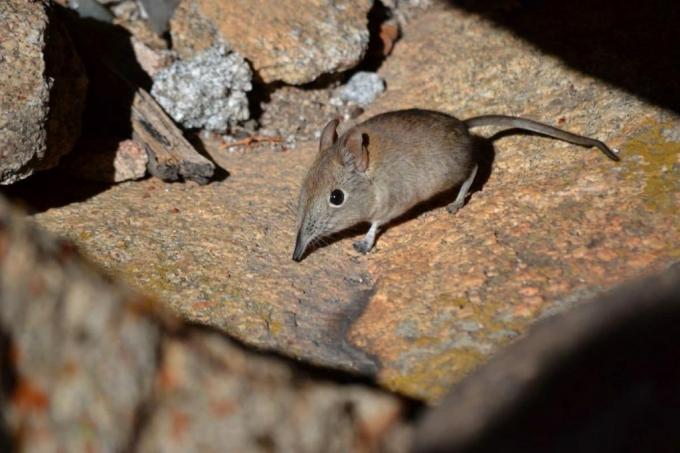
table of contents
- Songbirds
- Owl birds
- City birds
- Risk of confusion with shrew
- frequently asked Questions
There are only a few species of birds that can be heard at night. These include some songbirds, but mostly owl birds. The most common night singers are presented here.
In a nutshell
- few birds sing at night
- Apart from songbirds, nocturnal birds of prey call
- Shrews can be mistaken for the chirping of birds
- in bright areas, more species of birds sing at night
Songbirds
Common redstart (Phoenicurus phoenicurus)
The common redstart is one of the most common birds in the garden that sing very early in the morning or even at night. As a half-cave or Cave breeder he likes to use old trees.

- Appearance: Males very high-contrast colored, visual field, throat and beak black, whiter Stripes above the eyes, head to neck gray, chest orange-red, belly whitish, females more inconspicuous, red-brown to beige
- Diet: small insects, their larvae, spiders, berries
- Singing: three recurring parts per stanza, variable, imitations of other songbirds, longer pauses at night
Occurrence: As a long-distance migrant, the common redstart overwinters in Africa. In summer it is native from Europe to Central Asia. He prefers gardens or parks, but also light deciduous forests.
Larks (Alaudidae)
The skylark is best known, but the family is very species-rich. Basically they are not typical night singers, but you can also hear them on bright nights, for example when the moon is full. Since their singing is very melodious and they like to imitate other bird calls, they are easily mistaken for the nightingale.

- Appearance: medium size, inconspicuous brown, hardly any gender differences, females may be a bit smaller and lighter
- Diet: mostly seeds and insects
- Singing: varied, often singing flights, from dawn to evening
- Occurrence: Larks are found all over the world. The skylark is found mainly in Asia and Europe. Typically it lives in agricultural areas.
Nightingale (Luscinia megarhynchos)
The only bird that actually sings deep in the night is the nightingale. Her voice usually rings around midnight. The males look for females ready to mate in spring.

- Appearance: small, about the size of a house sparrow, inconspicuously brown in color, hardly any gender differences
- Diet: insects, in the cold season also fruits of bushes
- Singing: only males sing, pleasant, varied, imaginative, mating calls at night, territorial defense during the day
- Occurrence: Nightingales are native to Europe, Asia and North Africa. Because they are migratory birds, European populations overwinter in Africa. The nightingale was also brought to Australia by humans.
Marsh Warbler (Acrocephalus palustris)
Like the reed warbler, the reed warbler also belongs to the reed warbler genus and is widespread, but is rarely perceived as a night singer.

- Appearance: small, inconspicuous brown-gray, hardly any gender differences
- Diet: insects, their larvae and spiders
- Singing: late in the evening until late at night, typical reed singer sounds and imitated bird calls
- Occurrence: Marsh warbler are migratory birds and are found all over Europe. They move to Africa at the end of summer. They inhabit dense bushes or reeds near the water. Sometimes they also nest in grain fields.
Note: The reed warbler and the reed warbler are difficult to distinguish.
Owl birds
Owls are not songbirds, but their calls are particularly characteristic at night. Therefore you can also call them night singers. Typical for owls is the nocturnal way of life, which not only includes hunting, but also reproduction. Since they start breeding very early in the year, their calls can be heard at a completely different time of the year, like the songs of the songbirds.
Note: How many owls there are in a year often depends directly on the size of the local mouse population.
Barn Owl (Tyto alba)
The barn owl is one of the most beautiful European owls. The light plumage with the even lighter, heart-shaped face veil is typical.

- Appearance: medium-sized, slender, upper side light brown, gray plumage markings, belly side light, often colored white, eyes dark
- Diet: small mammals, in Central Europe mainly mice and shrews
- Voice: In contrast to other species of owl, the call of the barn owl is more like a loud screeching.
- Occurrence: Barn owls are found worldwide, mainly in warmer zones. The Central European Barn Owl has one of the northernmost distribution areas. It occurs in open, structured landscapes.
Eagle owl (Bubo bubo)
The eagle owl is the largest European owl species. He is not as used to humans as other owls that even breed or hunt indoors.

- Appearance: wingspan over 150 cm, females become larger and heavier than males, the plumage is brown, black and red-brown colored, speckled in the branches for camouflage, typical feather ears that can be put on, orange-yellow eyes
- Diet: not limited to small mammals, rabbits and brown hares, small predators, larger birds, and other owls as well
- Voice: The courtship call of the male eagle owl, from which it owes its name, is typical. It can be heard from afar and resembles a “buho”, while the female replies with an “uhu”.
- Distribution: Eagle owls are native to Europe, Africa and Asia. They prefer mountains and low mountain ranges. The eagle owl is sometimes completely absent in the heavily agricultural plains. Few breeding pairs nest in cities.
Tawny Owl (Strix aluco)
In addition to the long-eared owl, the tawny owl is the most common type of owl in Central Europe. He inhabits landscapes rich in trees, which, however, must necessarily have open areas for hunting. The tawny owl is a cave breeder, but also lives in buildings.

- Appearance: small, stocky owl, plumage similar to bark, very variable in color, coloring also depends on the habitat, no feather ears, females heavier than males, insignificant greater
- Diet: mice, if there are too few small mammals, also small birds
- Voice: The calls of the tawny owls can be heard from far and wide at night. Courtship songs and district songs contain different variants of the typical "Hu". Females respond with their own distinctive call.
- Occurrence: The tawny owl is widespread from Europe to Asia. He mainly inhabits well-structured landscapes with bushes and groups of trees. Despite its name, it doesn't necessarily depend on forests.
Long-eared Owl (Asio otus)
The long-eared owl looks similar to the tawny owl, but has feather ears and is slimmer. It inhabits similar habitats.

- Appearance: females contrasting russet, yellow-brown and black, males overall lighter, eyes orange-red
- Diet: mainly mice, also hunts songbirds
- Voice: Especially in the early evening, the male's muffled call, which resembles a "huh", can be heard in the district. It is repeated continuously and continues into the night.
- Occurrence: The long-eared owl is found in Europe, Asia, in the mountains of Africa and in Canada or based in the United States. It often nests in conifers, in which there are old crow or magpie nests.
City birds
Songbirds in particular, which have adapted to life close to humans and breed in cities, can tend to let their songs be heard at night because of the bright lighting. These include:
- Blackbirds
- Chokes
- Sparrows
- Titmice
- Common Swift
Risk of confusion with shrew
Shrews communicate by chirping sounds that are very similar to the song of some songbirds. Since they are also nocturnal, they can easily be mistaken for a night singer.

frequently asked Questions
Watching songbirds or owls at night is not easy because they are sensitive to any disturbance. A night vision device may help. Owls and owls are also visible as shadows flying along between trees and bushes. However, they are difficult to determine.
The main reason is mutual understanding. In addition, songbirds mark their territory with their song. Sometimes warning calls from certain bird species can also be heard at night. Another reason is the formation of pairs, then only unpaired males sing at night.
Owls mainly live in forests or at least in their vicinity, but they also come to tree-lined gardens, where they rest almost invisibly high up in the treetops during the day. Nocturnal songbirds usually live in hedges or gardens with rich trees or shrubs.

